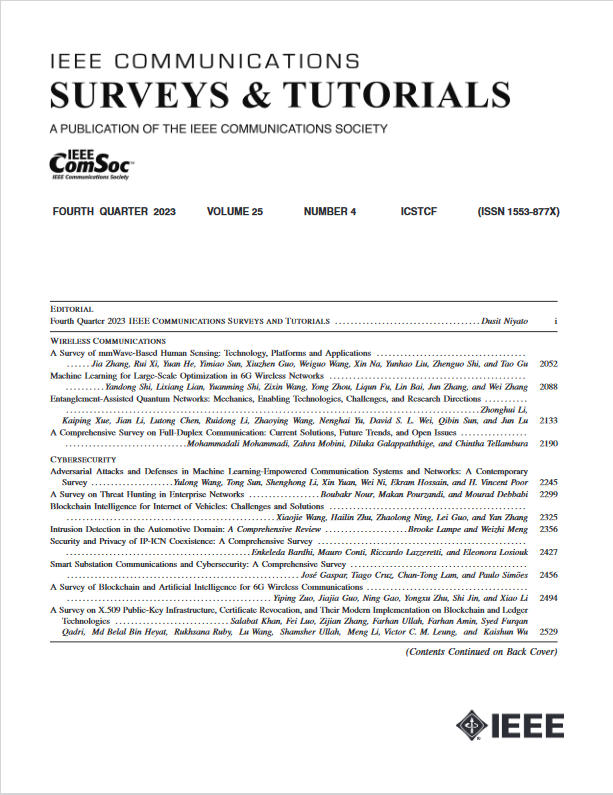脑机接口通信调查:机遇与挑战
IF 34.4
1区 计算机科学
Q1 COMPUTER SCIENCE, INFORMATION SYSTEMS
引用次数: 0
摘要
脑机接口(bci)旨在通过实时采集和处理大脑信号,直接连接人脑与外界。近二十年来,在脑机接口范式和解码算法方面取得了巨大的进展。BCI系统的信息传输速率显著提高,通信界正在考虑将BCI技术纳入6G及以后的网络。然而,一些关键的问题和挑战仍然存在。脑机接口系统在某种程度上类似于无线通信系统,大脑信号由神经元产生和传输,由传感器接收,在多个脑组织中传播,不可避免地会产生衰减和混合效应。因此,遵循这一思想,通过与无线通信的比较,对BCI技术进行了系统的回顾。脑机接口的主要挑战在于脑通道建模、调制、信号处理和检测。涵盖了最新的和一些经典的研究。此外,还预测了脑机接口的典型应用,如体验质量(QoE)度量和脑联网(IoB)。在此基础上,展望了bci与未来无线通信系统集成的前景。此外,讨论了实现这一前景的通信和计算方面的技术挑战,以及隐私、安全和道德问题。因此,本文旨在从脑机接口本身作为一个通信系统和脑机接口与通信的未来融合作为一个整体系统两个层面全面概述脑机接口激发的通信。本文章由计算机程序翻译,如有差异,请以英文原文为准。
A Survey on Brain-Computer Interface-Inspired Communications: Opportunities and Challenges
Brain-computer interfaces (BCIs) aim to directly bridge the human brain and the outside world through acquiring and processing the brain signals in real time. In recent two decades, tremendous progress has been made in terms of BCI paradigms and decoding algorithms. The information transfer rate of the BCI systems has been significantly enhanced, and the communication community are considering including the BCI technologies into the 6G networks and beyond. However, some critical problems and challenges remain. To some extent, the BCI systems resemble the wireless communication systems, as brain signals are generated and transmitted by the neurons and received by the sensors, propagating through multiple brain tissues which cause inevitable attenuation and mixing effects. Therefore, by following this idea, a systematic review of the BCI technologies is provided through comparing it with wireless communications. The main challenges of BCI lie in brain channel modelling, modulation, signal processing and detection. The latest and some classic researches are covered. In addition, typical applications of BCIs such as the Quality-of-Experience (QoE) metric and Internet-of-Brains (IoB) are predicted. Then, we present a prospect of BCIs being integrated with future wireless communication systems. Also, the technical challenges regarding communication and computation to fulfill the prospect are discussed, as well as privacy, security and ethical concerns. Therefore, this review aims to comprehensively overview BCI-inspired communication on two levels, the BCI itself being a communication system and future integration of BCI and communication as a whole system.
求助全文
通过发布文献求助,成功后即可免费获取论文全文。
去求助
来源期刊

IEEE Communications Surveys and Tutorials
COMPUTER SCIENCE, INFORMATION SYSTEMS-TELECOMMUNICATIONS
CiteScore
80.20
自引率
2.50%
发文量
84
审稿时长
6 months
期刊介绍:
IEEE Communications Surveys & Tutorials is an online journal published by the IEEE Communications Society for tutorials and surveys covering all aspects of the communications field. Telecommunications technology is progressing at a rapid pace, and the IEEE Communications Society is committed to providing researchers and other professionals the information and tools to stay abreast. IEEE Communications Surveys and Tutorials focuses on integrating and adding understanding to the existing literature on communications, putting results in context. Whether searching for in-depth information about a familiar area or an introduction into a new area, IEEE Communications Surveys & Tutorials aims to be the premier source of peer-reviewed, comprehensive tutorials and surveys, and pointers to further sources. IEEE Communications Surveys & Tutorials publishes only articles exclusively written for IEEE Communications Surveys & Tutorials and go through a rigorous review process before their publication in the quarterly issues.
A tutorial article in the IEEE Communications Surveys & Tutorials should be designed to help the reader to become familiar with and learn something specific about a chosen topic. In contrast, the term survey, as applied here, is defined to mean a survey of the literature. A survey article in IEEE Communications Surveys & Tutorials should provide a comprehensive review of developments in a selected area, covering its development from its inception to its current state and beyond, and illustrating its development through liberal citations from the literature. Both tutorials and surveys should be tutorial in nature and should be written in a style comprehensible to readers outside the specialty of the article.
 求助内容:
求助内容: 应助结果提醒方式:
应助结果提醒方式:


